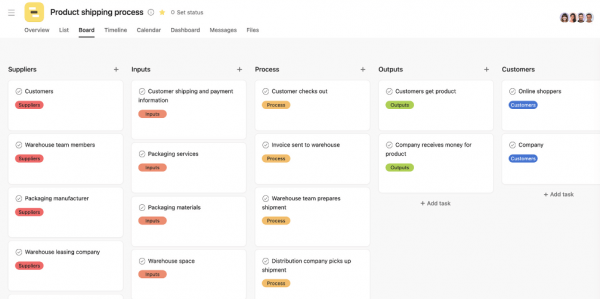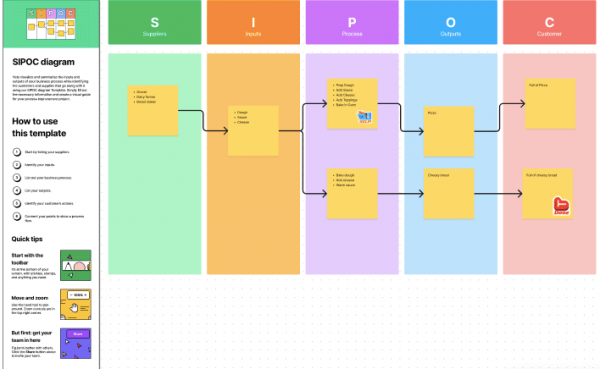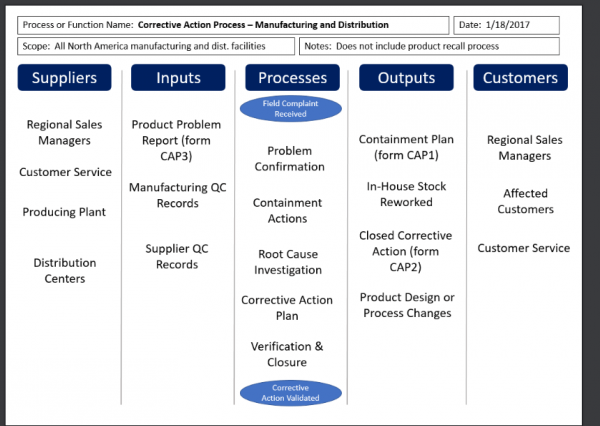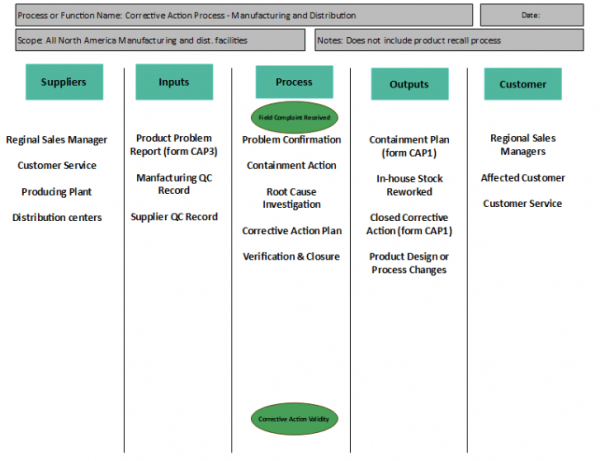SIPOC is the short form for supplier’s inputs, process outputs, and customers. Before any work is done, it describes a business process from beginning to end. Because the tool presented is a simplistic depiction, the thoughts in each of the components’ spaces should be as succinct and concise as feasible. To put it plainly, the purpose of the said tool is to identify the most important five to six steps of a process at a high level. This is an excellent approach to coordinating a team’s actions and focus swiftly.

Using SIPOC will provide helpful information on areas where big problems remain. Problems might emerge from the supplier’s end and can be linked to input specifications or processes and outputs that fail to fulfil customer expectations. It is possible to do so using internet mapping tools, making it incredibly valuable in today’s world.
The tool is advantageous and can be used in a variety of situations, particularly when dealing with challenges and problems in corporate operations. It provides helpful information on areas where significant issues remain. Problems may arise from the supplier’s side, and the problems could stem from certain things like input requirements, processes, or outputs that fail to meet customer expectations. It is possible to do so using internet mapping tools, making it incredibly valuable in today’s world.
The tool’s primary purpose is to detect all recent actions right away. A key part of the diagram is quantifying inputs and who supplies them, as well as the procedure required to transform them into outputs.
An internal customer is someone else within the organization that refines the output in extra processes for the external customer, whereas an external customer is a final user who initiated the process. A perfect example in this particular scenario could be a pedestrian who is thirsty.
That’s a basic SIPOC example and illustration of how it works, but it illustrates how precise you should be when making one. Every item must be utilized, as well as the method documented. It comes down to dissecting it into key components and locating them within the diagram
How to Create SIPOC Diagram
SIPOC is an essential visual tool that is easy to create. SIPOC tool helps define who the suppliers are, important raw materials as input, the process to be improved, the output of the process, and the customers that will receive the process output. Follow these steps to make the SIPOC diagram.
Outline the process
Begin by outlining the high-level process steps along with starting and ending points of the process. List five to seven process steps
Define Output
List key output of the process in this step. It is important to list only three to four important outputs even if the process produces more outputs.
Identify Customers
Identify the targeted audience who will receive the output of the process. The customers can be internal to the business or external.
List the Inputs
This step includes the resources and raw materials needed for the business process. List only three to five important inputs.
Define Suppliers
Suppliers are the source of input, and different inputs can have different suppliers. List all the suppliers who directly impact the output of the process.
Identify Customer requirements (Optional step)
This is an optional step in which the customer’s requirements are identified. These requirements are later verified in the measurement phase.
Discuss
In this step, the diagram is discussed with the project sponsor and stakeholders for verification and approval.
SIPOC Example
The lemonade stand, an early form of entrepreneurship that is reasonably simple to grasp, will be employed.

Supplier: They are the process’s source of inputs. Concentrate solely on those suppliers who have a direct impact on the process outputs, as the diagram is supposed to be succinct. This one represents whoever gives the process with input. In this case, it could be a supermarket, grocery store, farmer’s market, or customer requests.
Process: The process entails action taken on the material to meet the needs of the customer. This is where all the action takes place. So, it could involve the construction of a lemonade stand, the combining of ingredients so as to produce the lemonade in the jar, pouring lemonade from the jar into the glasses, and taking orders from the said customers.
Inputs: This part represents the material that is sent to the processing station for processing. So, it could be bottles or cans of water, ice, sugar, glasses or cups, lemons or lemon juice, containers, spoons, cups, people to operate stall, large pitchers, and wood from a home store, money storage containers, and an area with many pedestrians.
Outputs: The outputs are basically much the procedure that eventually produces altered material that meets the needs of the customer. They are usually a list of things produced, services given, actions accomplished, or knowledge received. So, in this particular example, it could be lemonade in a chilled glass or just money put in a container.
Customer: Discover who your customer is and what they require. A customer can be anyone who receives an output from the process. As a result, both internal and external customers are possible. It would be best if you also outlined the extent to which the consumer can influence your procedure during this step. The recipient of the process output can be internal or external. Also specifies the output criteria.
SIPOC VS COPIS
COPIS stands for, customer, output, process, input, and supplier. The other one is used often, SIPOC meaning is a popular process mapping technique that starts with the process and then moves on to the outputs and consumers. Then you determine the process’ inputs and the sources from whom you obtain them. COPIS takes the opposite approach and is more customer-centric.
In its creation, technology is not even a necessity. Sticky notes and a piece of paper on the wall will suffice. A broad mapping feature is included in various online collaborative applications. There are also other free templates that the team can download and fill out as they try to describe the process using the COPIS format.
COPIS starts with the consumer, not with the team’s assumptions about what is important to the client. Never make the assumption that you know your customer’s CTQs. Once the clients have been identified, the team can inquire about the outcomes they require without making any assumptions. The outputs are then specified by the procedures that result.
Once the processes are identified, determining the requisite inputs and suppliers is rather simple. COPIS is more customer-centric, and it can ensure that the CTQ criteria are addressed. Looking at the consumer first, then the process rather than forcing the customer’s needs to match what the process produces fits the process to the customer’s needs.
This traditional technique is favored for existing processes since it defines the present state (which is always the first step in process improvement) rather than a theoretical ideal state.
Advantages of SIPOC
You should use a SIPOC template because it is a basic tool that can be deployed quickly. A lot of information is also saved systematically and concisely, allowing for multi-group collaboration, which aids in creating shared projects.
As stated earlier, it is a beneficial tool and can be used in so many ways especially when it comes to overcoming obstacles and resolving issues in corporate operations. Below are detailed reasons as to why you should use it.
It helps in understanding how the process serves the customer
Each step of the process should provide value to the consumer. Both of them use this as a fundamental pillar. The tools model is utilized to make the process more effective and efficient. But none of this would be worthwhile if the client was not taken into account at every stage.
When using to analyze a process, it’s important to remember that each step must provide added value to the client. A value-added matrix could be used to supplement this. Where should all of a process’s procedures or activities be situated, and whether they bring value to the end customer?
It enables multi-group collaboration and helps create shared understanding.
There are techniques for bringing work groups together, such as marketing, which essentially pretends that the sales and marketing teams are working toward a similar goal. Its creation necessitates the participation of people from several disciplines.
The goal of collaborating with many groups is to make the process diagram as realistic as possible and to do so, specialists from each of the activities that surround the process must give their ideas and points of view. It also helps you to reacquaint personnel whose familiarity with a process has faded or become obsolete as a result of process changes.
It is a visual and simple tool
It is a tool that can be applied very easily. The fact that a lot of information may be stored in a systematic and succinct manner is a significant reason to utilize this graphic.
To thoroughly explain a process with many variables and verticals, you’ll need to produce a paper with multiple pages, which serves as a SIPOC example. This renders the practice of examining a process pointless, and the document’s author is unlikely to obtain meaningful comments on his work.
It can also be created by using internet mapping tools, making it incredibly helpful in today’s world. You could also use an A3 sheet or sticky notes if you wanted to undertake an exercise of this nature.
It provides a structured and easy way to brainstorm
Both the Customer Journey Map and the tools require the use of brainstorming. Deep down, you’re brainstorming by utilizing these tools. One of the most difficult aspects of producing ideas is maintaining control and a clear aim for each of the places where many people contribute a variety of thoughts.
An online visualization tool can quickly generate the needed diagram. This is because it is essentially a table on which the precise information of a process is displayed in a succinct and straightforward manner. You now have a tool that can be viewed as a brainstorming tool. The more structured the concepts are, the more useful they will be for a customer journey map.
It allows thinking beyond the process
This tool is used to understand all of the factors that influence a service or a product. In the Customer Journey Map, this global vision of watching from several perspectives is critical. A SIPOC example will be able to offer graphic answers to some specific questions when looking beyond the process:
- Who are the customers and who are the suppliers of the process?
- What are the outputs and the inputs? This can be materials services or information.
In addition to the reasons stated above, we can also say that its high-level overview is useful to quickly convey information about a process. It can also be used for the purposes of refreshing the minds of people who haven’t seen the process in a while.
It also assists in streamlining workflows, identifying and resolving problems, and eliminating inefficient tasks. It achieves so by visualizing the process and reducing the data to only what’s needed for the management to identify the areas that need to be improved.
A clear picture of processes is provided by diagrams. They are great at making sure that every one of the persons involved is on the same page. In addition, the tool’s model is the heart of the Six Sigma DMAIC methodology. This improves corporate operations, increases efficiency, and increases revenue while lowering operational expenses.
To sum it up, these are some of the reasons why a Customer Journey Map should include this kind of tool or the diagram. On a single map, you’ll discover various processes with multiple inputs while completing the diagram. Nonetheless, you can acquire more information on how to use the tool and learn more about these benefits in order to elevate the clients’ experience.
SIPOC FAQ
What is the difference between a process map and SIPOC?
A process map can be defined as a visual representation of the inputs, actions, and surplus of a process in a step-by-step diagram, on the other hand, the latter can be defined as a visual tool for documenting a business process from start to finish before it is implemented.
When should you use a SIPOC?
Given the numerous aspects that influence your company’s success, you should seize every chance to improve efficiency and customer happiness. It will show you the clear link between what customers want and what you get from suppliers, as well as how you combine the two in your process. This specific tool is typically used at the define phase of an issue because it provides a high-level view of the process and assists a belt in answering crucial questions about how they will manage their project. These include the scope, stakeholders, metrics, and communication channels. Without it, your project could be without a clear focus from the onset.
When should you use the process map?
A process map is carried out only when a procedure is first designed. It is carried out without input from the other workers. Process mapping is a method of illustrating the flow of a process using flowcharts, starting at the macro level and working down to the degree of detail required to discover chances for improvement. The process depicts what someone believes happened rather than what really happened. Without a detailed process map, you may miss some essential information that would derail your project.
SIPOC Full Form
SIPOC’s full form is the supplier, inputs, process, outputs, and, customers.
What is the use of the SIPOC diagram?
The primary purpose of the said diagram is to point out all the important steps of the project from the beginning. Most importantly, do not forget that measuring inputs and who sources them as well as the procedure required to convert them to outputs is an important aspect of the diagram. The diagrams are simple to create, which is their strength. Draw a high-level diagram of your process, including the received inputs and outputs. List the customers of these outputs as well as the input sources.














